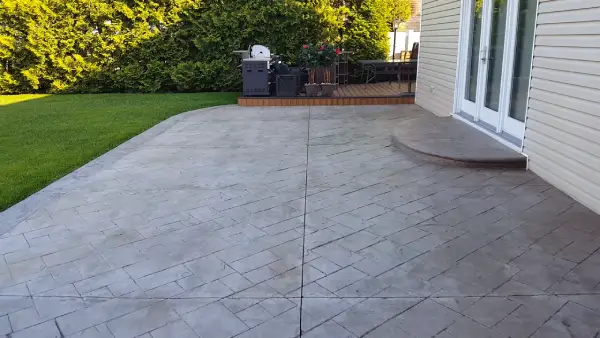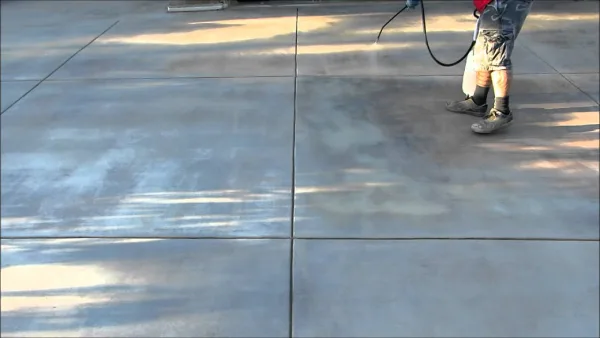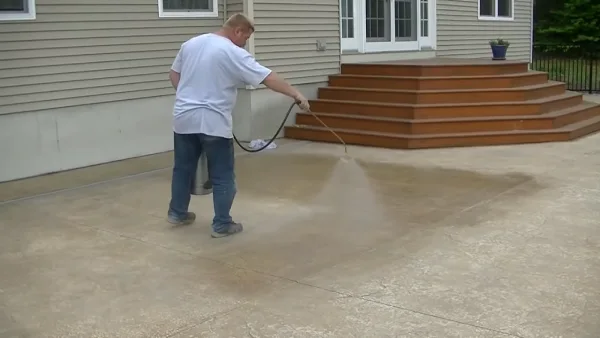Last Updated on February 6, 2023
Concrete sealers are an important part of maintaining the quality and integrity of your concrete surfaces. They provide a protective coating against water, UV rays, dirt, and other elements that could damage the surface over time.
But how long do these sealers last? Does concrete sealer go bad? The answer is yes; it’s possible for concrete sealer to expire or become ineffective with age and exposure to certain elements.
In this blog post, we’ll discuss factors that might affect the shelf life of concrete sealers, signs that a concrete sealer may have gone bad, and tips on how to prevent your concrete sealers from going bad.
Does Concrete Sealer Go Bad: Factors That Affect
The shelf life of concrete sealers can be affected by a variety of factors, including the type and quality of ingredients used, exposure to light and heat, exposure to humidity and moisture, chemical reactions with other materials, and incorrect or improper storage conditions.
In order to determine if concrete sealer will go bad or not, it is important to understand how these factors can affect the performance and longevity of the product.
1. Type and Quality of Ingredients:
One major factor that affects the shelf life of concrete sealers is the type and quality of ingredients used in their manufacture.
High-quality sealers typically contain more durable polymers which are able to stand up better to the rigors of outdoor exposure, while cheaper brands may use lower-grade ingredients that are more prone to breakdown over time.
As such, it is important to check the labels for both the manufacturer’s recommended shelf life as well as for information about whether or not a particular sealer contains high-performance polymers.
2. Exposure to Light and Heat:
Another factor that affects the shelf life of concrete sealers is their exposure to light and heat. Prolonged exposure to intense sunlight or extremely high temperatures can cause some sealers’ protective film coatings to break down faster than usual, reducing their effectiveness over time.
For best results, it is important store your products in a cool and dark place away from direct sunlight or any other sources of intense heat.
3. Exposure to Humidity and Moisture:
Moisture can also have an effect on the shelf life of concrete sealers due to its ability to degrade certain components within them over time. If a product has been exposed consistently damp environments or areas with high levels of humidity for prolonged periods, then its overall lifespan may be affected as a result.
To avoid this problem it is necessary that you keep your products dry at all times; if you are unable store them indoors then try wrapping them in waterproof material before putting them away for long periods outside.
4. Chemical Reactions with Other Materials:
Some kinds of concrete sealers may also experience degradation when they come into contact with certain kinds of chemicals such as solvents or paints, due to chemical reactions which take place between their components over time.
Whenever possible it is important therefore that you avoid using these products together; if you must use them together then always be sure that you clean off any excess residue immediately afterwards so as not cause any permanent damage your protective coating layer over time.
5. Incorrect or Improper Storage Conditions:
Finally, incorrect or improper storage conditions can also lead to reduced shelf life when it comes with regards to concrete sealers due too either too much light reaching them (leading oxidation) or because temperature fluctuations from freezing cold winter temperatures too hot summer one can cause cracking within their protective film layers degrading their performance levels significantly over time if no additional protective measures are taken beforehand (such as wrapping them in thermal insulation).
Therefore whenever possible make sure that you store your products carefully following manufacturers instructions – if uncertain contact them directly for further advice, so as ensure maximum product performance for years come by protecting against environmental degradation agents such as extreme temperatures & humidity levels changes .
Signs that a Concrete Sealer May Have Gone Bad

Change in Color, Appearance, or Consistency
The primary sign that a concrete sealer may have gone bad is a change in color, appearance, or consistency. Over time, the sealer can become cracked and brittle due to improper curing or exposure to UV light, which can cause it to take on a hazy or discolored appearance. Additionally, the sealer may thicken as it ages and become more difficult to apply as it loses its liquidity.
The surface finish of the concrete may also appear uneven if the sealer has gone bad. This can be especially noticeable on stamped concrete surfaces where the design pattern should remain consistent throughout.
It is important to inspect your concrete sealer regularly and re-apply when necessary so that you do not experience any of these issues. If you believe that the sealer has already gone bad, then you should remove it completely before applying a new coat and properly prepare the surface according to manufacturer instructions.
Odd Odors or Discoloration on Surfaces Treated with the Sealer
Another sign that a concrete sealer may have gone bad is odd odors or discoloration on surfaces treated with the sealer. If there is an unpleasant smell coming from your sealed concrete surfaces, then this could be due to microbial growth which occurs in areas where moisture has been retained by the sealant.
The seals can also develop yellowing or dark spots over time if they have not been properly applied or if they have aged beyond their intended lifespan. These issues are often caused by accumulated dirt and debris which slowly erodes away at the protection created by the sealing material over time.
If you notice any discoloration or odors coming from your sealed concrete surfaces then you should immediately seek out professional advice before attempting to fix it yourself as improper handling of these issues could cause further damage to your floors.
It may also be necessary to completely remove any existing coatings before applying a new one as this will help ensure that all contaminants are removed from within the pores of the concrete itself before reapplication takes place.
Cracking or Peeling Surfaces Treated with the Sealer
Finally, cracking and peeling of surfaces treated with a sealant can be another telltale sign that something isn’t quite right with your concrete sealing application.
These cracks usually indicate that there has been an excessive amount of movement beneath the surface which causes stress fractures within the top layer of protection provided by the selaant itself.
Over time these fractures continue until eventually chunks of material begin falling off entirely in some cases appearing similar to small clumps of paint chips being peeled away from its base surface layer below them.
In order to avoid cracking and peeling problems arising from misapplied concrete seals its important to always follow manufacturer instructions closely and allow plenty of time for proper curing between successive coats when needed according to product specifications.
If any cracking appears while applying additional layers then immediate removal should occur followed by thoroughly cleaning off remaining adhering particles in order for proper adhesion during reapplication afterward taking place correctly once again in order for maximum long term performance results
How to Prevent Your Concrete Sealers from Going Bad

When you have invested in concrete sealers, whether it is for pool decks, patios, driveways, or any other concrete surfaces, the last thing you want is for the sealer to go bad. Fortunately, there are several steps you can take to help ensure that your concrete sealers provide a long-term protection and maintain their performance.
Store Correctly
The optimal way to store your concrete sealer would be at room temperature with a relative humidity level of 50%. This means that too much heat or moisture can cause the concrete sealer to degrade over time.
Therefore, it’s best to keep your containers or buckets away from direct sunlight and extreme temperatures. When storing indoors, make sure that the area is well ventilated and away from any sources of heat such as radiators or heating vents.
Avoid Mixing Different Types of Sealers Together
It is important not to mix different types of sealers together in the same container or bucket as this can cause chemical reactions that can degrade the quality of the sealer over time. If two different types of sealers are needed for a project, store them separately and apply each one when needed.
In addition, never mix in additives such as detergents or solvents as this could lead to degradation over time as well.
Use Proper Application Methods
To get optimal performance from your concrete sealer, it’s important to follow manufacturer’s instructions when applying it. This includes using proper application methods such as using thin layers and avoiding direct contact with pool water if applied around pools/spas.
For extra protection against weather damage and UV rays, some products offer multi-layer applications where multiple coats are applied sequentially within a certain amount of time between each coat being applied.
This can also help extend the life of your concrete sealer even further than one coat alone could do so make sure to check with your manufacturer on details regarding multi-layer applications if they are available for their product line.
Obtain Higher Quality Sealers
When looking for new products for sealing concrete surfaces always look for higher quality materials which will naturally increase their shelf life due to better formulation and ingredients used during production process.
The higher quality products will cost more than standard lower grade alternatives but they will also provide better protection in most cases making up for its initial cost in long term usage savings due increased longevity of usage before needing repairs or reapplication again compared lower quality items which may need replacing sooner than expected resulting in unfavorable costly repairs budget overruns.
How do you revive a concrete sealer?
Reviving a concrete sealer depends on the type of sealer used, as well as its current condition. Generally speaking, if the sealer is still in good condition, it can be revived by lightly sanding and re-applying the same product. If the sealer has begun to break down or discolor, then it is likely to need to be removed before reapplication.
A solvent-based stripping solution should be used to remove any existing sealers before applying a new one. For harder-to-remove residues, a pressure washer may be needed to thoroughly clean the surface before refinishing and resealing with a fresh coat.
How often should you apply concrete sealer?

The frequency of application will vary depending on several factors such as type of concrete, climate conditions, usage levels and more. A general rule of thumb is that most types of concrete sealers should be applied every two years.
However, if the area experiences heavy foot traffic or other high wear and tear activities then it might need to be reapplied yearly or sooner. Additionally, some climates may require more frequent applications due to temperature fluctuations or humidity changes that could potentially accelerate the deterioration of the sealant over time.
Is it better to roll or spray concrete sealer?
It really depends on what kind of project you are completing and your own personal preference for application style. Spraying is typically faster and more efficient than rolling but can lead to overspray if not done carefully. Rolling can provide a more even coverage but may take longer depending on the size of your project area.
The best way to determine which method would work best for you is through trial & error testing with both techniques prior to beginning your project so you can find out which works best for your particular needs & situation.
Is it better to spray or roll concrete sealer?
As stated above, this really depends on what kind of project you are completing and your own personal preference for application style. Spraying tends to be faster and more efficient than rolling but can lead to overspray if not done carefully while rolling provides a more even coverage but may take longer depending on the size of your project area.
Testing both techniques prior can help determine which works best for your particular needs & situation before starting any project involving sealing concrete surfaces.
Should I clean the concrete before sealing?
Yes! Cleaning a surface properly prior to sealing is necessary in order for any coating material (such as an epoxy or clear acrylic) or protective compound (such as wax) used in conjunction with the actual sealant material (such as silicone) will adhere correctly and last longer when applied onto a clean surface free from dirt, dust particles or other contaminants like oil stains etc.
Additionally, improper cleaning preparation can result in an ineffective bond between the substrate surface with product being applied leading eventual degradation/deterioration of performance quality due too irregular adhesion points over time.
Conclusion
It’s essential to understand what can affect the shelf life of your concrete sealer in order to get the most out of your investment. Different types and qualities of ingredients can impact its longevity; exposure to light and heat, humidity, moisture, and chemical reactions with other materials can all contribute to reducing its shelf life.
Furthermore, improper storage conditions can also lead to premature spoilage or expiration. By being aware of these factors and taking steps such as storing your sealer properly and using it within its specified shelf life, you can help ensure that you get the most out of it!



